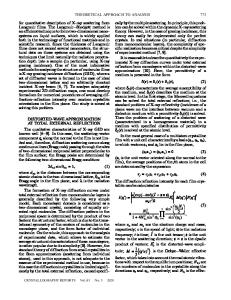Interface Structure of Epitaxial Nb Films on Sapphire: Grazing Incidence X-Ray Diffraction and X-Ray Reflectivity Studie
- PDF / 288,307 Bytes
- 5 Pages / 420.48 x 639 pts Page_size
- 108 Downloads / 307 Views
INTERFACE STRUCTURE OF EPITAXIAL Nb FILMS ON SAPPHIRE: GRAZING INCIDENCE X-RAY DIFFRACTION AND X-RAY REFLECTIVITY STUDIES C. H. Leel,*, K. S. LiangI, F. S. Shieu 2 ,+, S. L. Sass 2 , and 3 C. P. Flynn 1 Corporate Research, Exxon Research & Engineering Company, Annandale, NJ 08801 2 Department of Material Science and Engineering, Cornell University, Ithaca, NY 14853 3 Department of Physics, University of Illinois, Urbana, IL 61801 ABSTRACT The interface structure of MBE grown Nb films on sapphire substrates was studied using grazing incidence x-ray diffraction and x-ray reflectivity measurements. Specifically, the use of these x-ray techniques in probing the buried interfaces was demonstrated. Diffraction effects were observed which are consistent with the presence of misfit dislocations in the interface. INTRODUCTION Niobium films epitaxially grown on sapphire substrates have served as buffer layers for MBE growth of many metallic thin films [1]. The Nb-on-sapphire samples are also of interest for studies of model metal-ceramic interfaces. Of particular interest to this study is the recent TEM observation of dislocations at the Nb-A1 2 0 3 interface using internally oxidized Nb-Al samples [2] . It is the purpose of the present work to study these dislocations at buried interfaces by non-destructive x-ray techniques: grazing incidence x-ray diffraction (GIXD) and x-ray reflectivity [3] . Interfaces across which there is a lattice mismatch are expected to contain ordered arrays of misfit dislocations [4] . Although incommensurate structures with misfit dislocations have been extensively studied for adsorbed monolayer systems in the context of commensurateincommensurate transitions [5,6], such studies have not been performed specifically for buried interfaces. EXPERIMENTAL The GIXD measurements were carried out in a Z-axis surface scattering spectrometer [3] at Exxon beamline X1OA of National Synchrotron Light Source, Brookhaven National Laboratory. The x-rays from the eletron storage ring were focused by a bent cylindrical mirror and monochromatized by a double crystal monochromator of Ge(lll) . Pairs of slits are employed as an analyzer in the diffracted beam with in-plane resolution of about 0.005 A-1 . The Nb thin films were grown on the sapphire substrates by a MBE method [(] . X-ray measurements were carried out in both surface-parallel (i.e. in-plane) and surface-normal directions at different grazing incidence angles. The critical angle of xrays of Nb is 0.294" for the 1.129 A x-rays employed in this study. The thickness of the films is about 120 A as determined from specular x-ray reflectivity measurements. The crystal mosaic of the sapphire substrates is 0.006'. Nb films were found Mat. Res. Soc. Symp. Proc. Vol. 209.1a1991 Materials Research Society
680
to grow epitaxially by following the sapphire crystallographic plane despite a miscut of -1.4'. The in-depth structure of the films was probed with GIXD by varying the incidence angle of xrays. In our studies, three groups of films were investigated which
Data Loading...









